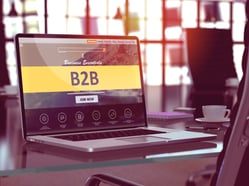
It seems as though, in the last year, there has hardly been one company that has not tried to figure out a way to go digital and run business over the internet. Ecommerce is a familiar model for most business-to-consumer (B2C) organizations. In 2020, it became rapidly familiar to many business-to-business (B2B) enterprises as well, and many entered the ecommerce space for the very first time.
B2B ecommerce surged in 2020 as a way to help counteract the effects of global supply chain disruption and lockdowns and is predicted to continue transforming well into 2021. Organizations will begin implementing the latest technologies to bring in customers, improve supply chain efficiencies, and give their clientele a more personalized user experience. In fact, by this time next year, B2B ecommerce could look a whole lot more like B2C ecommerce. And if “everyone else is doing it,” then B2B organizations hoping to jump on the ecommerce bandwagon in 2021—or improve what they started building reactively in 2020—will need to ensure their customer experience is excellent.
Here are a few B2B ecommerce business trends that experts predict we’ll see in 2021.
B2B Marketplaces Are Key
Online marketplaces aren’t a new concept. Sellers have been using them for years to provide a wider selection of both suppliers and products. Now marketplaces are becoming a staple for B2B ecommerce as well. According to one study, almost 90 percent of B2B buyers are currently purchasing on online marketplaces.
B2B companies will find it critical in 2021 to have a marketplace strategy, whether that’s running their own marketplace (as many larger enterprises do) or selling on another marketplace.
Marketplaces will typically be horizontal—including products every business needs, such as resale goods and office supplies—or vertical, focused on a specific industry group and connecting suppliers to key buyers. A few select marketplaces, such as Amazon Business, work both ways. However they are established, marketplaces have become popular with buyers because they allow businesses to see a variety of products in one place and purchase from multiple suppliers.
B2B That Looks Like B2C
The millennial generation—a generation that has known online shopping all its life—is quickly becoming the biggest part of the global workforce. As these employees move their ecommerce experience into the workplace, they’ll be looking for and expecting a similar online shopping experience with B2B ecommerce as they are used to with B2C. B2B ecommerce retailers who can capitalize on this popular modeling will find success with this group of buyers.
Echoing the B2C experiences means empowering B2B ecommerce shoppers with the right tools to research products and services on your site. This could include everything from cross-selling strategies that automatically recommend related products to ratings and reviews from other buyers. B2B ecommerce sellers will want to also provide self-serve “size and fit” information—detailed product information, measurements, photos, videos, even documentation—so customers can do all the research they need to make a purchase.
Skipping the “Middle Man” With Direct-to-Consumer Sales
Different from B2C, direct-to-consumer (DTC) sales allow B2B businesses to make a larger array of product available than may typically be found in a distributor or retail location. How is DTC different? Consider a major sports brand. The brand sells to distributors and retailers so certain styles of their shoes are available in running stores, while other limited varieties are offered at a general shoe store. Still other options might be sold at a sporting goods store. Consumers purchase the brand-name shoes from a variety of B2C consumer retailers, either in person or online.
With DTC, consumers can purchase directly from the brand itself, accessing a larger selection of merchandise than would typically be available at their favorite B2C ecommerce store or retail location. While many manufacturers have kept their distance from end consumers, fostering that direct relationship now provides valuable consumer data for product testing and direct input. DTC selling runs the risk of creating channel conflict, but it is possible to manage it in a way that works for all the companies across the supply chain.
Skip Mobile for Progressive Web Apps
Even business purchases are made on mobile devices. It might be tempting to think this means your B2B ecommerce efforts must include developing a mobile app, which can be expensive to create and manage. Instead, many businesses are turning to progressive web apps (PWAs). These web-based tools behave like mobile apps, but are built using common web technologies that enable a customer to simply visit a website. For consumers who like the usability and speed of apps, a PWA will provide the same experience. At the same time, B2B businesses can focus on maintaining a single website that works on desktop, laptop, and mobile without the time, cost, and upkeep of a mobile app.
PWAs also make it easier to support remote sales teams out in the field, giving them the power to display product catalogs and even place orders for customers right then and there.
Support B2B Ecommerce With the Right ERP
There’s a lot of opportunity for B2B ecommerce to grow in 2021, and businesses that stay on top of trends will have a better chance of success and stability in a still-uncertain market. Supporting B2B ecommerce, however, starts with having the right back-end software and processes to build on, such as ERPs and accounting software. The right ERP can integrate with your ecommerce platforms to help create the best possible customer experience throughout the buying process.
If you’re planning to build your B2B ecommerce presence, make sure you have a fit for purpose ERP system in place to support it. PositiveVision has been helping B2B organizations find the right ERP for their needs for decades. Let us help you get the right business software in place to support a robust B2B ecommerce process. Talk to an ERP software expert now.


 © 2019 PositiveVision • 219 E. Thorndale Ave. Roselle, IL 60172
© 2019 PositiveVision • 219 E. Thorndale Ave. Roselle, IL 60172